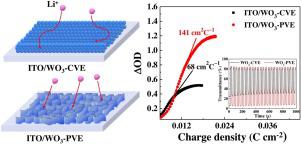当前位置:
X-MOL 学术
›
J. Ind. Eng. Chem.
›
论文详情
Our official English website, www.x-mol.net, welcomes your feedback! (Note: you will need to create a separate account there.)
Amorphous-crystalline dual phase WO3 synthesized by pulsed-voltage electrodeposition and its application to electrochromic devices
Journal of Industrial and Engineering Chemistry ( IF 6.1 ) Pub Date : 2021-02-01 , DOI: 10.1016/j.jiec.2020.10.047 Vu Hong Vinh Quy , In-Rok Jo , Soon-Hyung Kang , Kwang-Soon Ahn
Journal of Industrial and Engineering Chemistry ( IF 6.1 ) Pub Date : 2021-02-01 , DOI: 10.1016/j.jiec.2020.10.047 Vu Hong Vinh Quy , In-Rok Jo , Soon-Hyung Kang , Kwang-Soon Ahn

|
Abstract A facile one-step pulsed-voltage electrodeposition (PVE) is used to prepare nanoporous amorphous-crystalline dual-phase tungsten trioxide (WO3) thin films onto indium-doped tin oxide (ITO) glass substrates. The dual-phase WO3 films exhibit superior electrochemical and electrochromic abilities because the amorphous WO3 disordered structure provides many ion trapping sites, and the crystalline WO3 imbedded in the amorphous matrix improves the electron mobility. Besides, the highly porous morphology not only enhances the electrochemical active surface area, but also offers an efficient pathway for ion diffusion and charge transfer. The nanoporous amorphous-crystalline PVE-WO3 thin films possess a large optical modulation (ΔT) of 80.1% at 700 nm, fast switching speed (tc/tb) of 2.9 s/2.1 s, and high coloration efficiency (CE) of 141 cm2·C−1 at 700 nm. On the other hand, single phase amorphous or crystalline WO3 films exhibit inferior electrochromic performances with ΔT of 57.23% and 62.51%, tc/tb of 3.7 s/2.9 s and 4.1 s/3.3 s, and CE of 68 and 63 cm2·C−1 at 700 nm, respectively. In addition, the amorphous-crystalline PVE-WO3 films exhibit excellent cycling stability (sustain 94.5% of the initial optical modulation after 25 cycles) and maintain their colored state for a longer time under open circuit, when compared to the conventional amorphous WO3 film. These results suggest that the amorphous-crystalline dual phase WO3 prepared by one-step PVE can be employed as an economical, highly efficient, and stable electrode material in various applications such as electrochromic smart window, batteries, supercapacitors, and photoelectrochemical water splitting cells.
中文翻译:

脉冲电压电沉积法合成非晶双相WO3及其在电致变色器件中的应用
摘要 使用简便的一步脉冲电压电沉积 (PVE) 在掺铟氧化锡 (ITO) 玻璃基板上制备纳米多孔非晶结晶双相三氧化钨 (WO3) 薄膜。双相WO3薄膜表现出优异的电化学和电致变色能力,因为无定形WO3无序结构提供了许多离子捕获位点,嵌入在非晶基质中的结晶WO3提高了电子迁移率。此外,高度多孔的形态不仅增强了电化学活性表面积,而且为离子扩散和电荷转移提供了有效途径。纳米多孔非晶态 PVE-WO3 薄膜在 700 nm 处具有 80.1% 的大光学调制 (ΔT),2.9 s/2.1 s 的快速切换速度 (tc/tb),以及在 700 nm 处达到 141 cm2·C-1 的高着色效率 (CE)。另一方面,单相非晶或结晶 WO3 薄膜表现出较差的电致变色性能,ΔT 分别为 57.23% 和 62.51%,tc/tb 分别为 3.7 s/2.9 s 和 4.1 s/3.3 s,CE 为 68 和 63 cm2·C分别在 700 nm 处为 -1。此外,与传统的非晶 WO3 薄膜相比,非晶态 PVE-WO3 薄膜表现出优异的循环稳定性(在 25 次循环后保持初始光调制的 94.5%)并在开路下保持其着色状态更长时间。这些结果表明,一步 PVE 制备的非晶-结晶双相 WO3 可作为一种经济、高效、稳定的电极材料用于各种应用,如电致变色智能窗、电池、超级电容器、
更新日期:2021-02-01
中文翻译:

脉冲电压电沉积法合成非晶双相WO3及其在电致变色器件中的应用
摘要 使用简便的一步脉冲电压电沉积 (PVE) 在掺铟氧化锡 (ITO) 玻璃基板上制备纳米多孔非晶结晶双相三氧化钨 (WO3) 薄膜。双相WO3薄膜表现出优异的电化学和电致变色能力,因为无定形WO3无序结构提供了许多离子捕获位点,嵌入在非晶基质中的结晶WO3提高了电子迁移率。此外,高度多孔的形态不仅增强了电化学活性表面积,而且为离子扩散和电荷转移提供了有效途径。纳米多孔非晶态 PVE-WO3 薄膜在 700 nm 处具有 80.1% 的大光学调制 (ΔT),2.9 s/2.1 s 的快速切换速度 (tc/tb),以及在 700 nm 处达到 141 cm2·C-1 的高着色效率 (CE)。另一方面,单相非晶或结晶 WO3 薄膜表现出较差的电致变色性能,ΔT 分别为 57.23% 和 62.51%,tc/tb 分别为 3.7 s/2.9 s 和 4.1 s/3.3 s,CE 为 68 和 63 cm2·C分别在 700 nm 处为 -1。此外,与传统的非晶 WO3 薄膜相比,非晶态 PVE-WO3 薄膜表现出优异的循环稳定性(在 25 次循环后保持初始光调制的 94.5%)并在开路下保持其着色状态更长时间。这些结果表明,一步 PVE 制备的非晶-结晶双相 WO3 可作为一种经济、高效、稳定的电极材料用于各种应用,如电致变色智能窗、电池、超级电容器、



























 京公网安备 11010802027423号
京公网安备 11010802027423号